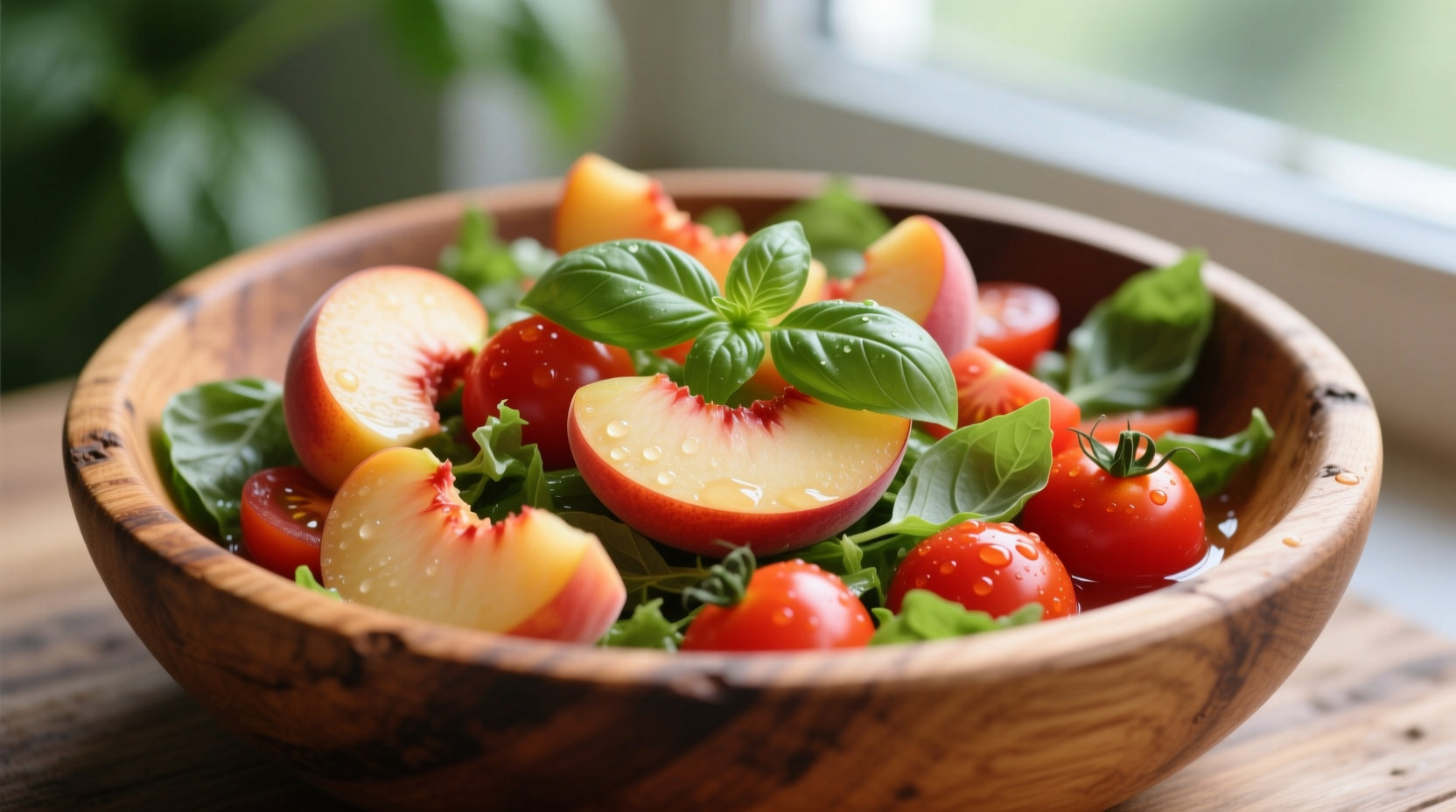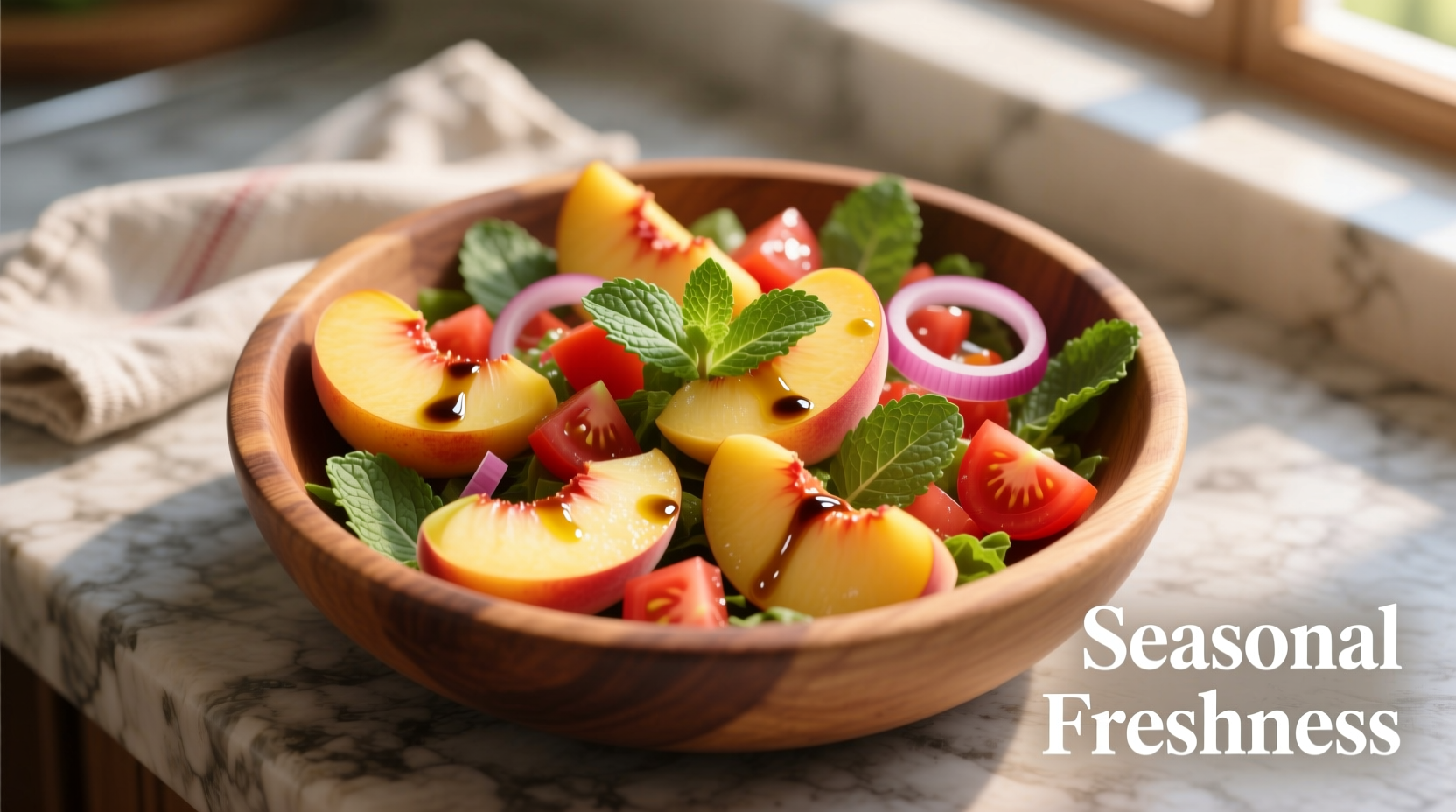Nothing captures summer's essence quite like a perfectly balanced peach and tomato salad. This vibrant dish harmonizes the natural sweetness of ripe peaches with the tangy freshness of garden tomatoes, creating a flavor profile that's both refreshing and satisfying. As culinary expert Antonio Rodriguez explains, "The magic happens when the fruit's natural sugars meet the tomato's acidity - it's a flavor chemistry that awakens the palate without overwhelming it."
The Essential Ingredients for Perfect Peach Tomato Salad
Creating an exceptional peach and tomato salad starts with selecting the right components. Quality ingredients make all the difference in this simple yet sophisticated dish.
| Peach Variety | Best For Salad When | Flavor Profile | Texture |
|---|---|---|---|
| Yellow Freestone | Peak season (July-August) | Bright, tangy sweetness | Firm yet juicy |
| White Peaches | Early season (June) | Milder, floral notes | Delicate, tender |
| Doughnut Peaches | Mid-season (July) | Exceptionally sweet | Soft, almost cotton-like |
According to agricultural data from the USDA Agricultural Research Service, peak peach season runs from May through September, with regional variations affecting availability. Tomatoes reach their flavor peak during the same window, making summer the ideal time for this salad.
Step-by-Step Preparation Guide
Follow these professional techniques to create a peach and tomato salad that impresses every time:
- Select and prepare produce: Choose 3 ripe but firm peaches and 2 cups mixed heirloom tomatoes. The University of California Cooperative Extension recommends gently pressing near the stem - if it yields slightly, it's ready to eat.
- Cutting technique: Slice peaches into 1/2-inch wedges (don't peel) and tomatoes into similar-sized chunks. This uniform sizing ensures balanced flavor in every bite.
- Dressing preparation: Whisk together 3 tablespoons extra-virgin olive oil, 1 1/2 tablespoons balsamic vinegar, 1 teaspoon honey, and a pinch of sea salt. As Antonio Rodriguez notes, "The honey balances the acidity without overpowering the fruit's natural sweetness."
- Assembly: Gently combine peaches, tomatoes, and 1/4 cup torn fresh basil leaves in a large bowl. Drizzle with dressing and toss carefully to maintain ingredient integrity.
Flavor Variations and Customization Options
This versatile salad adapts beautifully to different tastes and occasions. Consider these professional variations:
- Protein boost: Add 1/2 cup crumbled feta or goat cheese for a satisfying meal
- Crunch element: Include 1/4 cup toasted pecans or pine nuts for texture contrast
- Spice enhancement: A pinch of red pepper flakes complements the sweet-tangy profile
- Herb alternatives: Mint or tarragon work beautifully when basil isn't available
Food scientists at Cornell University's Food and Brand Lab have documented how adding contrasting textures (like crunchy nuts to soft fruits) increases perceived flavor complexity by up to 30%. This principle explains why the texture variations in these adaptations significantly enhance the eating experience.
When to Serve This Summer Salad
Understanding the seasonal timeline ensures you serve this salad at its absolute best:
| Time Period | Flavor Profile | Ideal Pairings | Best Occasions |
|---|---|---|---|
| Early Season (June) | Milder, delicate sweetness | Light seafood dishes | Spring celebrations |
| Peak Season (July-August) | Bright, balanced sweet-tart | Grilled proteins | Backyard barbecues |
| Late Season (September) | Deeper, concentrated sweetness | Hearty grain bowls | Fall transition meals |
This seasonal awareness comes from decades of culinary observation. As produce availability shifts, so does the salad's character - early season versions shine with lighter dressings, while late-season iterations can handle bolder flavor additions.
Serving Suggestions and Pairing Ideas
Maximize your peach and tomato salad experience with these professional pairing recommendations:
- With grilled proteins: Perfect alongside chicken, pork tenderloin, or salmon (the acidity cuts through rich meats)
- As part of a brunch spread: Complements quiches and egg dishes beautifully
- With grain bases: Serve over arugula, quinoa, or farro for a complete meal
- Wine pairing: A dry rosé or unoaked Chardonnay enhances the fruit flavors
According to hospitality research from the Cornell University School of Hotel Administration, salads with both sweet and savory elements increase overall meal satisfaction by creating flavor contrast that refreshes the palate between courses.
Storage and Make-Ahead Tips
While best served fresh, this salad can be prepared in advance with these professional techniques:
- Store undressed components separately in airtight containers
- Keep cut peaches in lemon water (1 tbsp lemon juice per cup water) to prevent browning
- Assemble no more than 30 minutes before serving for optimal texture
- Leftovers keep refrigerated for up to 24 hours (flavors meld interestingly)
Food safety guidelines from the FDA Food Code recommend keeping cut fruit and vegetables at 40°F or below and consuming within 24 hours for maximum safety and quality.

Why This Salad Works: The Flavor Science
Understanding the culinary chemistry behind this combination explains its universal appeal. Peaches contain natural sugars (fructose and glucose) that balance beautifully with tomatoes' citric and malic acids. The addition of basil introduces linalool compounds that enhance the perception of freshness, while quality olive oil helps carry fat-soluble flavor compounds across your taste receptors.
This flavor synergy follows the culinary principle of contrast and balance - a concept documented in Harold McGee's On Food and Cooking. The sweet-tart profile stimulates multiple taste receptors simultaneously, creating a more complex and satisfying eating experience than single-note dishes.











 浙公网安备
33010002000092号
浙公网安备
33010002000092号 浙B2-20120091-4
浙B2-20120091-4